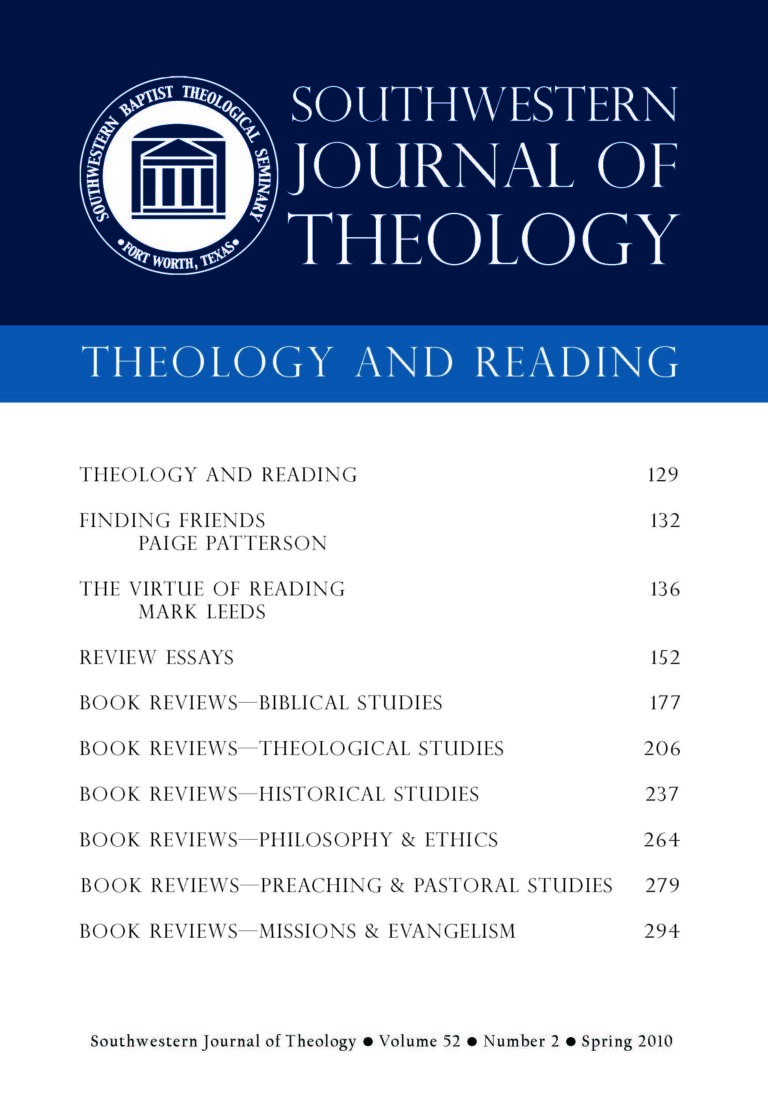
Theology and Reading
Southwestern Journal of Theology
Volume 52, No. 2 – Spring 2010
Managing Editor: Malcolm B. Yarnell III
By Franz Dünzl. Translated by John Bowden. New York: T&T Clark, 2007. 148 + xi pages. Paperback, $26.95.
The title of this book describes only one aspect; it is indeed brief. Despite the work’s brevity, however, it is very complete. The author, Professor of Early Church History at the University of Würzburg, Germany, takes his readers from the time of the New Testament through the major crises surrounding formulations of Trinitarian belief to the Council of Constantinople in 381; he then proceeds with a brief discussion of the period immediately following that council. Throughout, Dünzl explores the theological, scriptural, and political currents that form the background for the ancient church’s struggle to understand the relationship of the Father, Son, and Holy Spirit within a monotheistic framework.
This brief but surprisingly complete text is extremely helpful in guiding the reader through the complex path of discussions and controversies in the ancient church surrounding the Trinity. Moreover, Dünzl is clear without oversimplification. At times, his probing the issue brings to the surface details that are more of a concern to the specialist, such as questions of authenticity concerning correspondence between Dionysius of Alexandria and Dionysius of Rome in the third century (39). A reader approaching the study of the Trinity for the first time might find this detail superfluous or confusing, but in this way Dünzl forewarns his readers that the background of the ancient discussions is murky at times. Another area among many where the author avoids oversimplification is his discussion of the adjectives homoousios (“of the same substance”) and homoiousios (“of similar substance”); the former is usually associated with Athanasius, the latter with those who wished to emphasize the distinction of Father and Son with an implied subordination of the Son. Of interest here is Dünzl’s clarification that such Germanic peoples as the Visigoths turned to homoiousios in their understanding of the relationship of the Son to the Father. While identified as Arians (i.e., the Son is a creature), ancient Germanic peoples may have affirmed the Son’s Deity, although in subordination to the Father (130–31). Finally, the author sees the development of doctrine as a result of the discussions in “the living tradition of the church in a three-hundred-year-long history” (ix), and his brief history vividly reflects more clearly the struggles in which the creedal statements of 325 and 381, and the Chalcedonian definition of 451, were formed.
At the very beginning, one major concern evidenced by Dünzl is the issue of monotheism and the relation of Christianity to the other monotheistic religions, Judaism and Islam. This concern, which the author shares with Charles Kannengiesser (as expressed by Kannengiesser at the most recent meeting of the North American Patristics Society in Oxford in August 2007), forms the subject matter of the first chapter. Typical of Dünzl’s brevity and depth, the chapter both sets forth features shared by the three religions and puts in relief the issue of the Trinity, which complicates Christian monotheism. The author thus explores the ways in which the Christian community struggled to maintain monotheism within the understanding of Christ as God’s Son, and later of the Holy Spirit. Implicit here is an appreciation both of the theological framework shared by Christianity, Judaism, and Islam, and of the way in which the confession of God as One and Three marks Christianity as unique.
In his last chapter, Dünzl asks whether the formulation of the Trinity by the Neo-Nicenes (those involved in the Council of Constantinople) is still relevant today. The author admits that Platonic philosophy and imperial intervention were factors in the development of the doctrine of the Trinity. Nevertheless, he sees those factors as instructive in the way God and human beings work together in exploring what is, in the final analysis, a mystery: One God in Three Persons. For Dünzl, the statements by the ancient Church concerning this mystery can still guide the contemporary Church.
This brief work is of tremendous value and help for students of the development of doctrine in the patristic era; it reveals the complexity of the debates, the basic issues involved in those debates, and the continuing impact that ancient doctrine can have at the present time. As with any work, this text has features of which a reader needs to be aware. Dünzl’s study is foundational but brief; it is not final. Other works need to be studied for a detailed look, and Dünzl himself points his readers to other sources for further information. Furthermore some readers may have difficulty with the author’s higher-critical view of Scripture; whatever one’s approach to Scripture, however, Dünzl’s views on that subject do not detract from the main thrust of this book. John Bowden, the translator, has rendered a great service by making this brief but complete text available in English.





